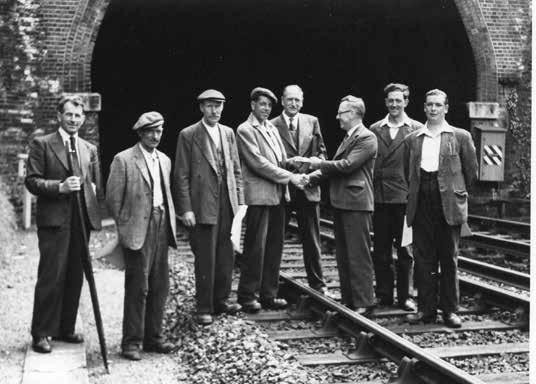
17 minute read
LINKING ELECTRIFICATION & LABOUR SUPPLY
ESL, THE ELECTRIFICATION AND CIVIL ENGINEERING SPECIALIST, HAS BRANCHED OUT TO OFFER SOLUTIONS IN THE LABOUR SUPPLY MARKET, FORGING A LINK BETWEEN ELECTRIFICATION AND LABOUR SUPPLY.
ESL Resourcing is the firm’s dedicated labour resource division, providing specialist rail electrification, civil engineering and safety critical operatives to client’s projects, as well as its own.
Founded in 2015 with the aim of developing an innovative business that could deliver a complete electrification service, ESL offers a design and delivery capability able to deliver on a wide range of projects. The firm has partnered with large clients to support them with the electrification elements of their multidisciplinary projects, and also delivered stand-alone packages of electrification works.
The success of ESL’s new venture is reflected by its recent award of a place on the £150 million Network Rail Frontline Labour Framework, to supply specialist rail electrification operatives throughout the UK. The programme will run over the next five years with a possible extension until 2029, and ESL will support Network Rail to deliver its programme of rail electrification projects throughout CP6 and CP7. The success of its Network Rail bid was based on its commitment to build the best and most reliable pool of rail electrification resources in the UK.
DOING THINGS DIFFERENTLY
As a specialist in electrification engineering and delivery, ESL understands the challenges faced by Network Rail and its supply chain in regard to the limited supply of labour available across the UK. As opposed to the traditional labour agency model, ESL will provide a structure based on its existing model of self-delivery that adapts with the changing demands of Network Rail and reacts to resourcing issues when they arise.
“ESL approaches labour supply slightly differently,” said the firm’s Head of Commercial, Matthew Hardy. “Our strategy towards recruitment is based on three principles. First, we use our knowledge of the UK electrification industry to identify and attract the best resources in the market. Second, we target individuals currently outside of the industry but with obvious transferable skillsets. Finally, we look to sectors of society that are currently underrepresented in the industry and try to find people with the right mindset and motivation to forge a career in the rail sector.”
And although labour supply is a relatively new venture for ESL, bringing the management of staff resources inhouse has been a game changer for the company, allowing it to better match its site requirements with the necessary competencies, and ensure each project is delivered by staff with the appropriate level of experience. This has helped the company to ensure safe and efficient delivery whilst maintaining industry leading quality and workmanship.
TOP QUALITY PEOPLE
ESL’s aim is to provide the best people for the job at hand and it has assembled a pool of experienced staff, incentivising them with attractive packages and a commitment to health, safety and well-being. “We went into this with the aim of building a core team of top-quality people,” said Matthew, “And we know that to attract and retain staff we need to provide a good environment for workers. We’re dedicated to providing job security and excellent working conditions for our staff.”

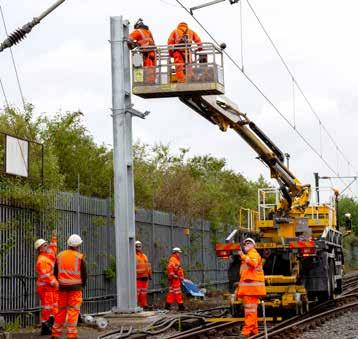
Looking further ahead, ESL is committed to bringing new blood into the industry. It has already developed a robust apprentice programme, allowing staff to complete their studies whilst gaining ‘on the job’ experience with them to support their learning.
CREATING OPPORTUNITIES
The company is dedicated to creating opportunities for those who may not previously have considered a career in rail engineering. “Our overall aim is to improve the quality of labour available to ESL and supply them to clients,” said Matthew, “And we can do this by tapping previously overlooked pools of talent. An example would be ex-service people who may find it difficult to find work but who can bring a wealth of key skills, or attracting staff whose experience may lie in other industries - aviation engineers, for example.”
ESL has also joined the UK Government’s Kickstart programme, which is designed to provide new job placements for 16–24-year-olds on Universal Credit who are at risk of longterm unemployment. The Kickstart Scheme is a £2 billion fund to create hundreds of thousands of high-quality, sixmonth work placements. Through the scheme, companies are able to access a large pool of young people with potential, ready for an opportunity. Already, ESL has seen the benefits of joining the initiative. “An abundance of people have come to ESL through the Kickstart scheme,” says Matthew. “It’s a tough time for young people seeking work and currently two to three years’ worth of graduates are fighting for one years’ worth of jobs.” COMMITMENT TO STANDARDS
The company has recently become a corporate member of the Recruitment and Employment Confederation, marking an important milestone in the development of its labour supply division. All of ESL’s operatives are thoroughly vetted in regard to competencies, qualifications and experience and the move demonstrates its commitment to operating in accordance with the highest standards in the industry.
The success and failure of multi-million-pound infrastructure projects regularly comes down to the quality, experience and reliability of the individuals on the ground during a given shift or possession, and ESL is dedicated to providing the right solution for the job, whether that’s individual operatives or full teams, supervisors, or construction management.
Now that it is part of the Frontline Labour Framework, Network Rail can direct companies to use ESL for engineer supply and, with a huge amount of electrification work in the pipeline, ESL will be a very good draw.

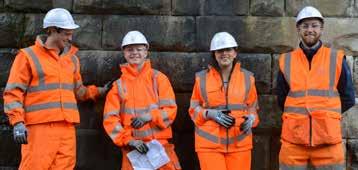
ADVANCE TRS
CELEBRATES 10-YEAR MILESTONE

Andy Ridout. In September, the recruitment consultancy Advance TRS celebrated its tenth year in business and enjoyed some well-deserved anniversary celebrations in London.

Since its humble beginnings in 2011, Advance TRS has grown significantly, becoming a £25 million turnover business, and working closely with clients and candidates to provide a five-star recruitment service.
In 2020 alone, the business welcomed seven new members to its ever-expanding teams in Guildford and Port Solent. So, what’s next on founder and Group Managing Director Andy Ridout’s agenda?
EXCITING CHANGES
With 25 years of industry experience, Andy is no novice and has ambitious plans for his business. He recently revealed some exciting changes for Advance TRS after 10 years of growth and outlined his plans for the next five years. It’s safe to say that the business’ future is looking bright.
Andy recognises the important role that strong working relationships play in the company’s success. “While the last 12 months have been challenging, we’re very fortunate to have a loyal client base and motivated staff that are integral to driving the business forward,” he explained.
He was also delighted to share that additional staff will be joining the company’s Guildford and South Coast teams. “The team on the South Coast have been hitting their targets and are performing well in every area, meaning we will be able to speed up growth plans for this division of the business.”
In the immediate future, Andy sees the team re-engaging with clients in a face-toface environment, enabling his team to have in-depth conversations about their clients’ needs, helping them get the right resources for their projects. For the longer term, Andy has revealed some exciting expansion plans.
“After setting up our Guildford and South Coast offices we are now opening a London office,” he said. “This will give us the opportunity to attract an even more diverse portfolio of recruitment consultants and offer a greater service to our clients and candidates. London will further expand our catchment area and we’re excited to take that next step.”
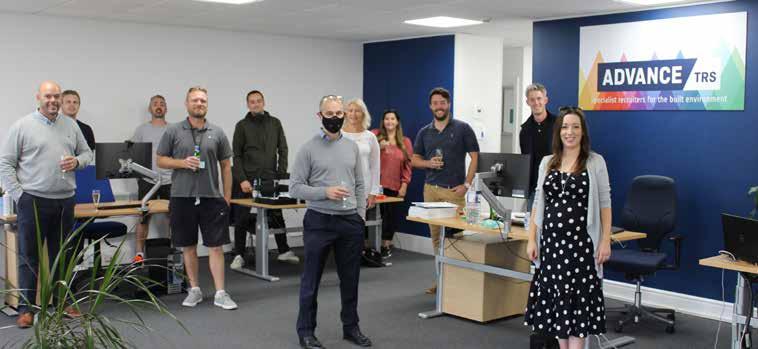

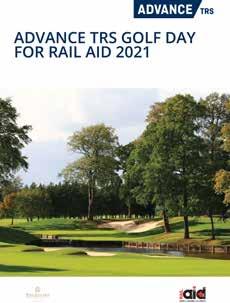

He is also planning to expand into further markets including highways, renewables, power, and nuclear, which will all complement the sectors the business operates in currently.
QUALITY OVER QUANTITY
Andy set up Advance TRS in 2011, with a view to providing a top-quality recruitment service for the built environment, focusing on building strong working relationships. “I come from a recruitment background. Prior to setting up Advance TRS, I’d already spent 15 years as a recruitment expert in the built environment. I wanted to offer a service that really focused on quality over quantity, building close relationships with clients, and getting a deep technical understanding of their needs.”
He grew the business quickly, expanding from rail recruitment into further sectors across the built environment that he knew would complement each other. He attracted well-known recruitment experts in the industry to the business, expanding on the team’s area of expertise. CHARITY GOLF DAY
One thing that hasn’t changed over the years is Andy’s passion for giving back. Knowing how challenging the past 18 months have been for most people, he knew the impact will have been even greater on charities and was keen to plan a big fundraising event.
This year, Railway Children and Advance TRS have teamed up to create the first annual Advance TRS Golf Day for Rail Aid, at the prestigious Belfry Hotel & Resort. Money raised by the event will help Railway Children partner with grassroots organisations with invaluable local knowledge and established community relationships, to support projects specific to the needs of the local area.
The day will bring together industry leaders for some healthy competition, networking and, most importantly, to raise money for the Rail Aid campaign. All proceeds from the Golf Day go directly to Rail Aid and to helping children in need.
Sponsors of the event will play a day of golf on the Ryder Cup Brabazon Course at the Belfry, followed by a three-course networking dinner, keynote speeches from former professional footballer and manager, Paul Merson, and HS2 CEO, Mark Thurston, followed by a silent auction for Rail Aid. JOIN OUR TEAM
As an expanding recruitment business, Advance TRS has great opportunities for career development. It prides itself on rewarding success and promoting from within. However, it is always looking for new talent to further strengthen and expand its teams.
As a recruiter, the company understands that talented and motivated staff are the key to any successful business. All of its staff receive invaluable mentorship from its experienced senior leaders and are able to shape a clear, bespoke career path, mapping out potential routes of progression within the company.
The company’s dedication to creating a great working environment was recognised at the 2018 Toast of Surrey Business Awards when Advance TRS was announced as Employer of the Year and Leadership Team of the Year.
To contact the company or find out more, visit www.advance-trs.com. The Advance TRS Golf Day for Rail Aid will be held on 20 October 2021. To find out more about the event and for details about sponsorship packages, email eg@advance-trs.com or marketing@advancetrs.com, or call on 01483 361 061.

A RETURN TO THE RAILWAY FAMILY COULD IT REDUCE AVOIDABLE ACCIDENTS?
Like many others I spent most of my working life in the employ of British Railways. I recall the original application form for employment I filled in, and my surprise that it asked me to list any family members who were already in their employment. I also remember my concern at being asked to countersign conditions of employment that clearly specified that I must agree to live “within a mile of my home station”. But there were distinct and real advantages to being part of a dedicated organisation that tried hard to do what was best for the railway.
Workforce motivation is best when it comes from feeling you are part of the railway family. We all benefit if everyone working on the railway feels they belong and works together to stay safe and get the job done. Sadly, today there are still individuals who look to work around rather than follow the rules and best practice, which we need to be able to work safely. ‘Human factors’ played a large role in the recent incidents that follow, but I wonder if these could have been avoided had the individuals involved felt they were working as part of a greater entity?
An avoidable near miss
A Safety Digest from the Rail Accident Investigation Branch (RAIB) was issued on 30 September following a near miss at 04:12 on the morning of 22 July. A Class 390 Electrical Multiple Unit (empty coaching stock) was travelling from Longsight Depot to Lancaster and, as it approached Eccles Station in Greater Manchester, the driver saw workers wearing reflective clothing on the track. He sounded the train horn and applied the emergency brake. The workers managed to get clear with four seconds to spare before the train passed them travelling at 69 mph. The Controller of Site Safety (COSS) saw the train come to a stop and rang the signaller from his mobile.
The plan was for safeguarded working. The workers were a contractor’s painting staff and the COSS (from an agency) was the nominated Person in Charge. Similar work painting white lines on the platform edge had been completed on each of the previous three nights, with Patricroft Station being painted earlier that same night. The line blockage covered both lines and stations between 00:01 and 05:00, protected by signals with no additional protection.
Discussions between the COSS and the signaller had confirmed that scheduled trains were running, work would need to stop, and the blockage be given up for each train to pass. Calls to take and give back took between two and eight minutes.
At 04:10 the COSS told the signaller that the line was clear, and trains could operate, but he had not told the workers. At 04:11 he contacted them using his mobile phone and told them to move clear. As the call ended, they heard the horn of the approaching train.
The Rule Book is clear, stating: “COSS should stay with your group so you are able to personally observe and advise everyone until work is completed and your group is no longer on or near the line.”
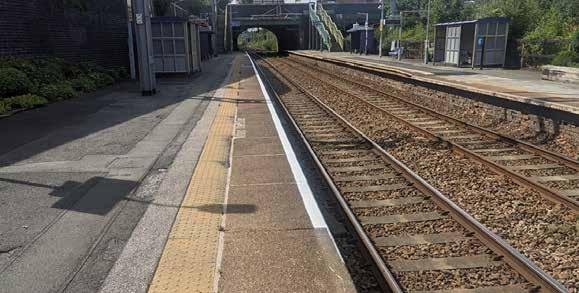
Colin Wheeler.
Lucky escape for MOM
September also saw the publication of RAIB’s Report 06/2021, following its investigation into a near miss with a Network Rail Mobile Operations Manager (MOM) at Rowlands Castle Station on 19 December 2020.
On that day the Prime Minister had announced the restrictive Tier 4 Christmas lockdown, which “caused the MOM considerable distress associated with personal circumstances”. The near miss occurred at 19:14 when the MOM came close to being struck by a
passenger train. He was on track retrieving a rubbish bag when the train approached at about 60 mph. The MOM climbed back onto the platform and was clear of the line just one second before the train passed.
The report states that “the incident happened because the MOM had not arranged protection from train movements before going onto the track. The MOM and the signaller did not have a mutual or accurate understanding of the reality of the situation, and consequently the MOM was unaware that the train was approaching.” Underlying causes are listed as being “associated with the MOM’s competence, which was not adequately managed to ensure he worked safely on the track, and local management not functioning properly, which probably affected the recruitment, training and ongoing monitoring of the MOM.”

Train strikes hand trolley
Network Rail’s Safety Central website has long ago earned my appreciation for its open approach to making those who work on its infrastructure aware of accidents and incidents which hopefully may reduce the likelihood of their being repeated.
On Wednesday 8 September a train struck a hand trolley that had been left on the Up Main near Twickenham Station. The trolley ended up stuck under the front carriage of the train. The area is fitted with axle counters using the Line Clear Verification process. The Safety Central reference is NRA21-14, and I hope to find an update explaining how the trolley was forgotten! Waterloo Underground fatality
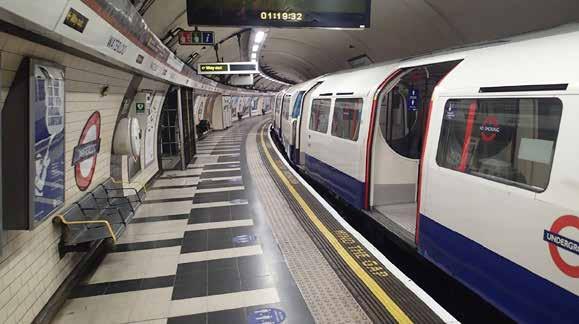
On 7 September RAIB published its report on the fatal accident involving a passenger that occurred at Waterloo Underground Station on 26 May last year. At around 10:10 that day the passenger fell between the platform and the Bakerloo line train from which he had just alighted.
The platform is curved and has platform mounted mirrors targeted on the platform train interface. The passenger was unable to free himself and the train departed with him still in the gap. The operator of the following train was unaware, being focussed on the platform and the trains stopping point.
RAIB found that London Underground’s risk assessment “did not enable the identification and detailed assessment of all factors that contributed to higher platform interface risk at certain platforms.”
It also found that “the model used to quantify risk makes no allowance for non-fatal injuries, and so understates the risk of harm to passengers”.
The RAIB report makes three recommendations. The first relates to location specific risks, the second to the need for “ongoing evaluation of existing safety measures” and the third to the “effective delivery of actions proposed by internal investigation recommendations”.
Collision between tram and cyclist
At 19:25 on 1 September a Manchester Metrolink tram travelling between Audenshaw and Droylsden on the East Manchester Line struck and seriously injured a child cyclist. At that location trams run in ‘on street’ mode. The cyclist was crossing Droylsden Road at a ‘Puffin’ pedestrian crossing which is controlled by road traffic and pedestrian signal lights.
RAIB’s investigation will consider the design and configuration of the crossing, how the crossing was risk assessed, legislation and industry guidance on the design and configuration of pedestrian crossings where trams run ‘on street’, and any “relevant underlying factors”.
Kisby UWC Collision
RAIB is investigating this accident which resulted in the derailment of a freight train. At 09:01 on the morning of 19 August, a Class 66 locomotive with 36 container wagons struck a loaded farm trailer on this User Worked Crossing (UWC) which is near March in Cambridgeshire. The train driver applied the emergency brake just six seconds before impact, but the train was consequently still travelling at 58mph when it struck the trailer.
The train ran on for 780 metres before stopping. Both drivers suffered shock and the train driver sustained minor injuries. It took four days for the recovery of the vehicles involved and the repairs to track and infrastructure so that trains could run again.
Kisby UWC is fitted with a telephone and “user operated powered gates” that are not interlocked with the railway signalling system. Signs at the crossing direct users to telephone to obtain permission from the signaller before opening the gates and crossing the railway. RAIB is investigating and has said it has “been unable to find any evidence that a request to use the crossing was made by the driver of the tractor involved”.
The way things were
Modern equipment, including computerised flows of information, has brought enormous benefits. But I believe that the railway has been damaged by the separation of its workforce into contractors, subcontractors, consultants and subconsultants, right down to individuals whose working employers change day-by-day. We all need to understand the strengths and foibles of those we work with.
Arguably, both efficiency and safety are improved by groups and individuals who know each other, warts and all. When we begin to learn more details of how Great British Railways will work, looking back and picking out what used to work well will surely be beneficial. As a taster you may like these pictures of yesteryear when prize lengths of track and improvements in track quality earned individual and gang recognition.


Prizes for best kept P Way Gangers length. Length showing greatest improvement during 1950. Category "B". Gang 3/93 Lingfield. A safe place for such a presentation to be made? All seem to be quite pleased. Photo date 02.07.51.
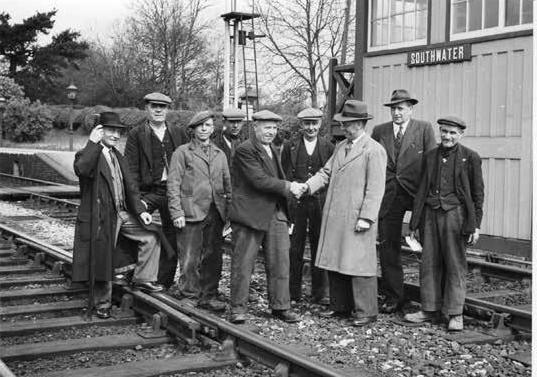
At least the signalman may have been aware of their presence? Photo date 28.04.52.
